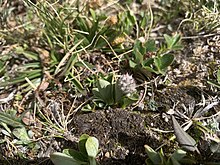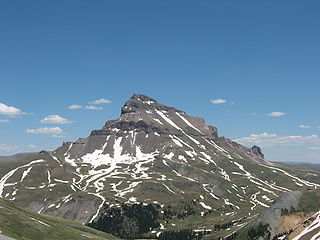
Uncompahgre Peak is the sixth highest summit of the Rocky Mountains of North America and the U.S. state of Colorado. The prominent 14,321-foot (4365.0 m) fourteener is the highest summit of the San Juan Mountains and the highest point in the drainage basin of the Colorado River and the Gulf of California. It is located in the Uncompahgre Wilderness in the northern San Juans, in northern Hinsdale County approximately 7 miles (11 km) west of the town of Lake City.

Boloria selene, known in Europe as the small pearl-bordered fritillary and in North America as the silver-bordered fritillary, is a species of butterfly of the family Nymphalidae. It is found across Europe, Asia and North America, and feeds exclusively on violets in its larval stages. This species prefers wet grassland habitats, where its larval food source, violets, are found. It overwinters in its larval stage, and eggs hatch in the late summer to early autumn. Members of this species are prey for multiple types of birds and other insects.

The marsh fritillary is a butterfly of the family Nymphalidae. Commonly distributed in the Palearctic region, the marsh fritillary's common name derives from one of its several habitats, marshland. The prolonged larval stage lasts for approximately seven to eight months and includes a period of hibernation over the winter. The larvae are dependent on the host food plant Succisa pratensis not only for feeding but also for hibernation, because silken webs are formed on the host plant as the gregarious larvae enter hibernation. Females lay eggs in batches on the host plant and are, like other batch-layers, selective about the location of oviposition because offspring survivorship levels for batch-layers are more tied to location selection than they are for single-egg layers.

Sunshine Peak is a fourteen thousand foot mountain peak in the U.S. state of Colorado. It is located in the San Juan Mountains in Hinsdale County approximately 9 miles (14 km) south west of Lake City, and about 1 mile (1.6 km) south of Redcloud Peak. It rises on the north side of the Lake Fork of the Gunnison River.

Boloria is a brush-footed butterfly (Nymphalidae) genus. Clossiana is usually included with it nowadays, though some authors still consider it distinct and it seems to warrant recognition as a subgenus at least.

Boloria chariclea, the Arctic fritillary or purplish fritillary, is a butterfly of the family Nymphalidae. It is found in the northern parts of the Palearctic and Nearctic realms.
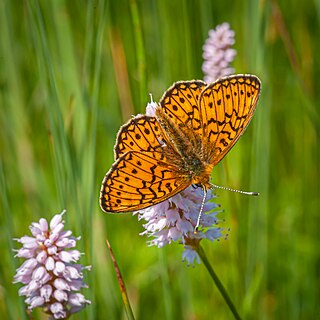
Boloria eunomia, the bog fritillary or ocellate bog fritillary is a butterfly of the family Nymphalidae.

Boloria titania, the Titania's fritillary or purple bog fritillary, is a butterfly of the subfamily Heliconiinae of the family Nymphalidae.
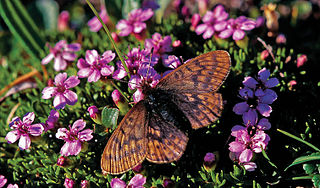
Boloria improba, the dingy fritillary, is a butterfly of the family Nymphalidae. In Europe it is only found in small parts of Scandinavia, more specifically the border region between Norway, Sweden and Finland. It is found in alpine or tundra habitats.

The ecology of the Rocky Mountains is diverse due to the effects of a variety of environmental factors. The Rocky Mountains are the major mountain range in western North America, running from the far north of British Columbia in Canada to New Mexico in the southwestern United States, climbing from the Great Plains at or below 1,800 feet (550 m) to peaks of over 14,000 feet (4,300 m). Temperature and rainfall varies greatly also and thus the Rockies are home to a mixture of habitats including the alpine, subalpine and boreal habitats of the Northern Rocky Mountains in British Columbia and Alberta, the coniferous forests of Montana and Idaho, the wetlands and prairie where the Rockies meet the plains, a different mix of conifers on the Yellowstone Plateau in Wyoming, the montane forests of Utah, and in the high Rockies of Colorado and New Mexico, and finally the alpine tundra of the highest elevations.

Speyeria mormonia, commonly known as the Mormon fritillary, is a North American butterfly belonging to the family Nymphalidae. It is highly diverse, having differentiated into several subspecies which occupy a wide geographic range. S. mormonia exhibits extreme protandry, which is the emergence of male adults before female adults. This has several consequences on male and female behavior. Habitat specificity is still being investigated, as there are few known environmental predictors, and S. mormonia appears to be associated with a wide range of habitats. This species is not under threat, and conservation efforts are generally not necessary.
Boloria alberta, the Alberta fritillary, is a butterfly of the family Nymphalidae. It is found in the North American Rocky Mountains of British Columbia and Alberta and in northern Montana.
Boloria natazhati, the Beringian fritillary, cryptic fritillary or Pleistocene fritillary, is a butterfly of the family Nymphalidae. It is found from northwestern Canada as far south as northern British Columbia.
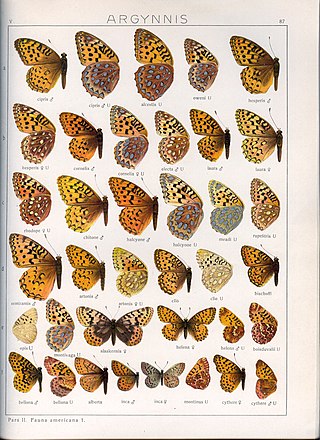
Boloria alaskensis, the mountain fritillary or Alaskan fritillary, is a species of fritillary butterfly in the family Nymphalidae. It was described by William Jacob Holland in 1900 and is found in North America and North European Russia. The MONA or Hodges number for Boloria alaskensis is 4462. The larvae feed on false bistort and alpine smartweed.

Precipice Peak is a 13,144-foot-elevation (4,006-meter) mountain summit located in Hinsdale County, of Colorado, United States. It is situated 10.5 miles northeast of the community of Ouray, in the Uncompahgre Wilderness, on land managed by Uncompahgre National Forest. It is part of the San Juan Mountains which is a subset of the Rocky Mountains, and is situated west of the Continental Divide. Topographic relief is significant as the west aspect rises 2,500 feet above the West Fork Cimarron River valley in approximately one mile. Neighbors include Dunsinane Mountain three-quarters of a mile north, Courthouse Mountain 2.4 miles northwest, and Redcliff 2.2 miles south. The mountain's name was officially adopted by the United States Board on Geographic Names in 1966. It is so named because of a very prominent precipice on the mountain's east face.
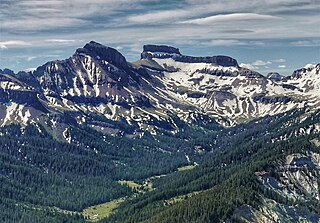
Coxcomb Peak is a 13,656-foot-elevation (4,162-meter) mountain summit located on the common boundary of Hinsdale County and Ouray County, in Colorado, United States. It is situated nine miles northeast of the community of Ouray, in the Uncompahgre Wilderness, on land managed by Uncompahgre National Forest. It is part of the San Juan Mountains which are a subset of the Rocky Mountains, and is situated west of the Continental Divide. Coxcomb ranks as the 171st-highest peak in Colorado, and topographic relief is significant as the south aspect rises 2,000 feet above Wetterhorn Basin in approximately one mile, and 4,400 feet above Cow Creek in three miles. Neighbors include Precipice Peak 2.7 miles to the north, Redcliff one-half mile north, Matterhorn Peak 2.3 miles to the east-southeast, and nearest higher neighbor Wetterhorn Peak 1.8 mile to the southeast. The mountain's descriptive name, which has been officially adopted by the United States Board on Geographic Names, was in use since at least 1906 when Henry Gannett published it in the Gazetteer of Colorado.

Redcliff is a 13,642-foot-elevation (4,158-meter) mountain summit located in Hinsdale County, in southwest Colorado, United States. It is situated nine miles northeast of the town of Ouray, in the Uncompahgre Wilderness, on land managed by Uncompahgre National Forest. It is part of the San Juan Mountains which are a subset of the Rocky Mountains, and is situated west of the Continental Divide. Redcliff ranks as the 175th-highest peak in Colorado, and topographic relief is significant as the west aspect rises 2,300 feet above the West Fork Cimarron River valley in approximately one mile. Neighbors include Precipice Peak and Dunsinane Mountain along the west-middle Cimarron divide three miles to the north, and nearest higher neighbor Coxcomb Peak one-half mile to the south. An ascent of Redcliff involves 3,300 feet of elevation gain and 10 miles of hiking, round-trip. The mountain's name was proposed by the Colorado Mountain Club, and was officially adopted in 1966 by the United States Board on Geographic Names. It is so named because of a large reddish-colored cliff on the mountain's east face.



